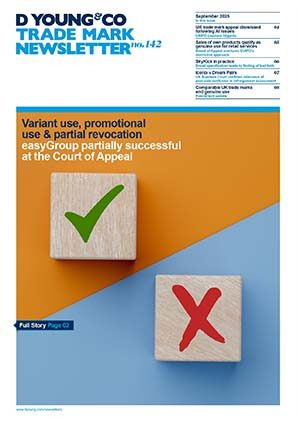EUIPO guidelines: more guidance now available
The new trade mark and design guidelines entered into force as of 01 February 2020. The design guidelines underwent no substantial changes and while there are no fundamental changes to the 2017 version of the trade mark guidelines, the new trade mark guidelines shed light on various aspects, which may have been on practitioners’ minds over the last years. Here we summarise some of the main changes:
Formalities: transparent elements of marks
If a mark includes transparent elements, the applicant may choose “other” type of trade mark as a category and use the description. Utilising the description field is an important feature for EU trade mark (EUTM) filings as the description is published as well. This is, however, different for designs where the descriptions are not published. Therefore, the EUIPO advised in its “Panel discussion on guidelines: main changes of practice” to avoid trying to identify invisible parts for registered Community designs altogether.
100% objection rate relating to regulations of use in the first year.
Formalities: regulations of use of collective and certification marks
After a 100% objection rate in relation to regulations of use (RoU) in the first year [see note 1], the EUIPO provided further guidance on how to draft RoU and even created a template for certification marks [see note 2]. Hopefully, this will reduce the objection rate in the future. Furthermore, the guidelines remind users that any transfer of collective or certification marks will require updating the regulations. Otherwise, the transfer will be refused.
Absolute grounds: public policy and principles of morality
Given the increasing number of EUTM applications including names of drugs, such as “CANNABIS”, the guidelines now state that such marks will be refused as contrary to public policy or acceptable principles of morality (Art. 7(1)(f) EUTMR) when the sign can be perceived to promote the use of the named drug.
Absolute grounds: geographical indications
The section on geographical indications has undergone a major change and users can rely on a section on direct or indirect use as well as misleading practices for clarification.
Absolute grounds: essential position of plant variety denominations
The guidelines now provide guidance on when a plant variety denomination occupies an essential position in the complex mark applied for based on the General Court’s decision in “Kordes’ Rose Monique” (decision of 18 June 2019, T-569/18).
Relative grounds
Users will find information on the impact of irregular capitalisations in word marks on the comparison of signs. In particular, the guidelines clearly state that such irregular capitalisations, such as “AIDAmia”, may justify breaking down a single word into components” [see note 3].
Proceedings: substantiation of marks in colour
One might think that this has already been the case before, but the EUIPO will no longer accept evidence in black and white for colour marks even if the rest of the submissions refer to the colour, for example, by naming it.
Cancellation actions should be substantiated together with the application.
Proceedings: substantiation in cancellation actions
Though this is not an admissibility requirement, the guidelines now expressly state that “cancellation applicants should submit all the facts, evidence and arguments in support together with the application” [see note 4]. Otherwise, there will be no basis for a meaningful exchange with the EUTM proprietor and the cancellation action may be rejected in case the EUTM proprietor does not file a response due to lack of substantiation.
Geographical indications
The guidelines now include substantial information on the scope of protection of geographical indications and the exploitation of their reputation. Notably, the guidelines clarify that geographical indications have an intrinsic reputation, which requires no substantiation. However, this does not exempt from the requirement to substantiate any exploitation of said reputation.
Goods and services: partial limitations
The EUIPO will now either accept or reject partial restrictions of EUTMs in their entirety. This means that the EUIPO will no longer accept a partial restriction in part. This aligns the procedure for partial restrictions with the one for partial surrenders.
Goods and services: retail services
When considering the similarity between goods and retail services, the EUIPO will now have a more detailed look at distribution channels. As a result retail services for similar goods may be considered of low similarity, for example “retail services in relation to clothing” and “footwear”.
Notes
- According to the “Panel discussion on guidelines: main changes of practice”.
- Available under (PDF): https://dycip.com/rou-eu-certification-marks
- See part C, section 2, chapter 4, 3.4.1.1.
- See part D, section 3, 3.2.

